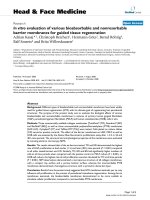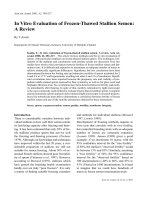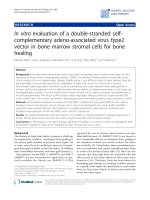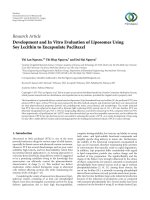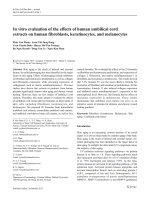In vitro evaluation of fungicides and botanicals against black banded disease of mango incited by peziotrichum corticolum (Rhinocladium corticolum) (Massee) subramanian
Bạn đang xem bản rút gọn của tài liệu. Xem và tải ngay bản đầy đủ của tài liệu tại đây (113.26 KB, 5 trang )
Int.J.Curr.Microbiol.App.Sci (2019) 8(10): 698-702
International Journal of Current Microbiology and Applied Sciences
ISSN: 2319-7706 Volume 8 Number 10 (2019)
Journal homepage:
Original Research Article
/>
In Vitro Evaluation of Fungicides and Botanicals against
Black Banded Disease of Mango incited by Peziotrichum corticolum
(Rhinocladium corticolum) (Massee) Subramanian
Komal Shinde*, P. G. Borkar, Aniruddha Deshmukh and J. J. Kadam
Department of Plant Pathology, College of Agriculture, Dapoli, India
Dr.Balasaheb Sawant Konkan Krishi Vidyapeeth, Dapoli, Dist.Ratnagiri 415712(M.S.), India
*Corresponding author
ABSTRACT
Keywords
Evaluation,
Fungicides,
Botanicals and
Peziotrichum
corticolium
Article Info
Accepted:
07 September 2019
Available Online:
10 October 2019
In an in vitro experiment, five fungicides viz., Mancozeb 75 % WP, Copper
oxychloride 50% WP, Bordeaux mixture (1.0%), Sulphur80% WP,
Difenoconazole 25% EC and Thiophanate methyl 70% WP were evaluated
against tested pathogen at different concentration. Three botanicals viz.,
Azadirachta indica, Lantana camara and Polyalthia longifolia were tested
against P. corticolum at 10 per cent concentration. Among different
fungicides, all the fungicides were statistically inhibited (100%) the
mycelial growth of pathogen except Copper oxychloride 50% WP and
Sulphur 80%WP. Extract of Azadirachta indica shows maximum inhibition
against tested pathogen which was recorded 55.55 per cent growth
inhibition and it was followed by Lantana camara (48.15%) and Polyalthia
longifolia (46.66%).
Introduction
Mango (Mangifera indica L.) belongs to
family Anacardaceae is known as “King of
fruits” and nectar of God being most palatable
and rich in sugar, organic acids and minerals
and thus captures great demand for all walks
of life (Azhar et al., 2007). India has a rich
wealth of mango germplasm with more than
1000 varieties grown throughout the length
and breadth of the country. However, only
about 21 of them like Alphonso, Banganpally,
Chausa, Dashehri, Langra, Totapuri and Kesar
are commercially cultivated in different
mango growing regions (Yadav, 1997).
Among them Alphonso tops the list and is
used as one of the choicest and prime variety
of India grown along the west coast of India in
Maharashtra, Gujarat, Goa and Karnataka
which has alone share of over 80 % in total
698
Int.J.Curr.Microbiol.App.Sci (2019) 8(10): 698-702
mango export (Burondkar et al., 2009). The
Konkan region comprising of Palghar, Thane,
Raigad, Ratnagiri and Sindhudurg districts is
famous for the quality mangoes. About 90
percent area under mango in the region is
occupied by single cultivar “Alphonso” which
is locally called as “Hapus” It thrives and
yields best under warm and humid climate of
the region and is the best variety for table and
processing purpose.
Although India is the largest producer of
mango, the productivity is low. This may be
due to the diverse climatic conditions in which
the mango is cultivated throughout the
country. So far, 140 diseases of mango have
been reported throughout the world. The
diseases such as pink disease, black banded
disease and die back are location specific or
area specific diseases which are posing an
emerging threat to mango orchards
particularly in humid tropics. These diseases
were reported from few pockets earlier but
very meager research work has been done on
these diseases as these diseases were
considered as minor diseases. In present era of
climate change and its impact on human
affairs and particularly on crop production,
these diseases will be of prime importance in
due course of time.
The damage caused to the plants due such
diseases is a gradual process but it
consequently leads to death of the plants and
that too in their maximum bearing phase.
Black banded disease commonly occurs in
monsoon season especially on the matured
branches of 20-30 years old mango plants. The
disease is being observed in serious
proportions in the coastal belt of the region
since the last three to four years
Plant Pathology, Dr. BSKKV., Dapoli and
standard methods were used as per the
reference of scientific research methodology.
Evaluation of fungicides
The efficacy of six fungicides was tested
against P. corticolum by poisoned food
technique. PDA was used as a basal medium.
Six fungicides were tested against the
pathogen by poisoned food technique (PFT) as
described by Nene and Thapliyal (1979).
Potato dextrose agar (PDA) was used as basal
medium and distributed in 100 ml aliquots in
each 250 ml Erlenmeyer conical flasks, which
were sterilized at 1.054 kg/cm2pressure for 20
minutes. The quantity of every fungicide was
calculated for 100 ml medium separately. The
weighed quantity of each fungicide was added
in lukewarm PDA at 40+2 0C, mixed
thoroughly and poured into sterilized petri
plates and allowed to solidify. The mycelial
discs of 5mm diameter were cut from 10 days
old culture with the help of a sterile cork
borer. A single disc was transferred aseptically
to the centre of each plate already poured with
poisoned medium. PDA plates without
fungicide but inoculated with fungal culture,
served as control. The plates were incubated at
room temperature (27+10C) Three replication
per treatment were maintained. The
observations on colony diameter were
recorded when Petri Plates in control
treatment were fully covered with mycelial
growth.
Per cent inhibition of growth of the test fungus
was calculated by the following formula
(Horsfall, 1956)
Y-Z
X= --------------x 100
Y
Materials and Methods
All the materials required for present research
programme were facilitated by Department of
Where,
699
Int.J.Curr.Microbiol.App.Sci (2019) 8(10): 698-702
X = Per cent inhibition of mycelium
Y = Growth of mycelium in control
Z = Radial growth of mycelium in treatment
Evaluation of botanicals
The effect of plant extracts on myceliaI
growth was studied by Poisoned Food
Technique (Nene and Thapliya, 1993). The
principle involved in this technique is to
poison the nutrient medium with fungitoxicant and allowing the fungus to grow on it.
The potato dextrose agar medium was used as
a basal medium. The methodology was same
as a mentioned below in the evaluation of
fungicides point.
Preparation of aliquot
One hundred gram fresh plant material was
weighed and thoroughly washed with tap
water followed by sterilized water. The plant
material was then homogenized in sterile
distilled water 1 ml/g of tissues with a pestle
and mortar.
well
as
both
systemic
fungicides
(Difenoconazole 25% EC and Thiophanate
methyl 70% WP) were completely inhibited
the growth of the pathogen in solid medium.
They were followed by COC with 33.33 per
cent and Sulphur with 18.52 per cent
inhibition of the mycelial growth. Gautamet
al., (2017) tested 5 contact fungicides, 3
combination fungicides and 3 systemic
fungicides against the pathogen and found that
Bordeaux mixture, Mancozeb, and COC
completely inhibited the mycelial growth.
These results are in concurrence with the
present findings in respect of Bordeaux
mixture and Mancozeb but contradictory in
terms of COC.
They also reported that, Difenoconazole is less
effective as compared to former fungicides.
This is in contradiction with the results of this
study as Difenconazole was found to be as
effective as Bordeaux mixture and Mancozeb.
Venkateswarlu (1989) reported Bordeaux
mixture as the best fungicide for control of
black banded disease under field conditions.
His conclusion is in conformity with present
findings.
The crude material was then expressed
through double-layered muslin cloth and was
centrifuged in a centrifuge machine at 5000
rpm for 20 minutes. After centrifugation, the
supernatant was taken and pellets were
discarded avoid bacterial contamination. This
formed the standard plant extract solution (100
per cent).
Effect of botanicals against P. corticolum
Results and Discussion
All the three plant extracts were effective
against the pathogen and statistically at par
with each other (Table 2). However, extract of
A. indica was numerically superior to the other
two extracts. Gautam et al., (2017) reported
11.11 per cent inhibition by using neem leaf
extract. The results of Gautam et al., (2017)
are remarkably diverging from the results of
this study.
Effect of fungicides on P. corticolum
The data depicted in Table 1 revealed that,
among the six fungicides comprising four
contact and two systemic fungicides, two
contact fungicides viz., Mancozeb 75 %
WP(0.25%) and Bordeaux mixture (1%) as
The aqueous extracts of three plant species
were tested against P. corticolum to exploit
their antifungal properties. All the plant
extracts were tested at 10 per cent
concentration by using poisoned food
technique.
700
Int.J.Curr.Microbiol.App.Sci (2019) 8(10): 698-702
Table.1 Effect of different fungicides against P. corticolum
Tr.
No.
Treatment
Detail
Conc.
(%)
Mancozeb 75 % WP
Copper oxychloride 50% WP
Bordeaux mixture
Sulphur
Difenoconazole 25% EC
Thiophanate methyl 70 % WP
Control
S. Em. ±
C.D. at 1%
T1
T2
T3
T4
T5
T6
T7
0.25
0.25
1
0.25
0.1
0.1
--
Per cent disease incidence
Mean colony
Per cent
diameter
inhibition over
(mm)
control
00.00
100
60.00
33.33
00.00
100
73.33
18.52
00.00
100
00.00
100
90.00
-1.67
7.01
Table.2 Effect of different botanicals against P. corticolum
Tr.
No.
Treatments
Conc. (%)
Mean colony
diameter (mm)
Azadirachta indica
10
40.00
Per cent
inhibition
over control
55.55
T1
T2
Lantana camara
10
46.66
48.15
T3
Polyalthia longifolia
10
48.33
46.66
T4
Control
-
90.00
-
S. Em. ±
1.86
C.D. at 1%
8.84
References
Azhar, N.M., Shirazi, Y.A., Khan, M.U.,
Parvez, M.A. and Ahmad, S. (2007).
Studies on Soil and Plant Micronutrients
Relationship of Mango orchards in
Hyderabad
District
of
Pakistan.
International Symposium on Prospects of
Horticultural Industry in Pakistan.I
nstitute of Horticultural Sciences,
University of Agriculture, Faislabad.
Burondkar, M.M., Jadhav, B.B. and Chetti,
M.B. (2009). Post flowering morpho-
physiological behaviour of Alphonso
mango as influenced by plant growth
regulators, polyamine and nutrients
under rainfed conditions. Acta Hort.820
425-432
Gautam C.H., VirupakshaPrabhu H and
Nargund V.B., 2017. Morphological and
Cultural Studies of Peziotrichum
corticolum
(Massee)
Subramanian
Causing Black Banded Disease of
Mango. International Journal of Current
Microbiology and Applied Sciences 6(4).
Horsfall, J.G. 1956. Principles of fungicidal
701
Int.J.Curr.Microbiol.App.Sci (2019) 8(10): 698-702
action. Chronica Botanica Co.USA.
Nene, Y.L. and Thapliyal P.N. 1979.
Fungicides in plant disease control.
Oxford and JBH publishing Co., New
Delhi. 413 pp.
Venkateswarlu R., 1989 Studies on Black
Banded Disease of Mango. M.Sc (agri)
Thesis (Published) Andhra Pradesh
Agriculture University, Pp. 13-76.
Yadav, I.S. (1997). Mango research in India
in the past 50 years. Indian Hort. 42
How to cite this article:
Komal Shinde, P. G. Borkar, Aniruddha Deshmukh and Kadam, J. J. 2019. In Vitro Evaluation
of Fungicides and Botanicals against Black Banded Disease of Mangoincited by Peziotrichum
corticolum (Rhinocladium corticolum) (Massee) Subramanian. Int.J.Curr.Microbiol.App.Sci.
8(10): 698-702. doi: />
702
